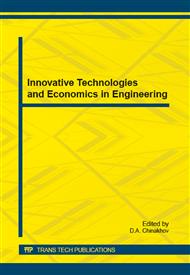[1]
Rosenberg A.M., Nasosov K.A. Factors influencing the deformation process when cutting. TPI 1957, vol. 85, P. 118-131.
Google Scholar
[2]
Eremin A.N., Rosenberg A.M. Cutting metal theory elements. M.; Sverdlovsk: State Publisher Machine engineering, 1956. – 319 p.
Google Scholar
[3]
Del G.D. Technological Mechanics. M., Machine engineering, 1978. – 174 p.4. Poletika M.F. Cutting Theory: Part 1: Cutting Process Mechanics. – Tomsk: TPU Publisher. 2001 – 202 p.
Google Scholar
[4]
Kufarev G.L., Govorukhin V.A. Okeanov K.B. Chipping and quality of a surface treatment in restricted cutting. Frunze: Mektep, 1970. – 170 p.
Google Scholar
[5]
Zorev N.N. Studies of elements of mechanics in cutting process. M.: State Publisher Machine engineering, 1952. – 364 p.
Google Scholar
[6]
Loladze T.N. Chip formation when metal cutting. M.: State Publisher Machine engineering, 1952. – 200 p.
Google Scholar
[7]
Sutton A., Peters W.H., Wolters W.J., Ransom W.F., McNeil S.R. Determination of displacements using an improved digital correlation method. Image and Vision Computing. 1983. – V. 1. – №. 3. – P. 133-139.
DOI: 10.1016/0262-8856(83)90064-1
Google Scholar
[8]
R.K. Rastogi, Digital speckle pattern interferometry and related techniques, John Wiley and Sons Ltd, New York, (2001).
Google Scholar
[9]
Alferova E.A., Lychagin D.V. Characterization of deformation pattern structure elements generated in uniaxial compression of nickel single crystals. Applied Mechanics and Materials. 2013. Vol. 379. – P. 66-70.
DOI: 10.4028/www.scientific.net/amm.379.66
Google Scholar
[10]
Luo P.F., Chao Y.J., Suttom M.A., Peters W.H. Accurate measurement of three-dimensional deformations in deformable and rigid boodies using computer vision. Experimental mechanics. 1993. – P. 123-132.
DOI: 10.1007/bf02322488
Google Scholar
[11]
Zuev L.B., Danilov V.I., Mnikh N.M. Fusion and interferometer method of displacement vector field registration in deformation. Plant Laboratory. 1990. - №. 2. – P. 90-93.
Google Scholar
[12]
Danilov V.I., Zuev L.B., Gorbatenko V.V., Gonchikov K.V., Pavlichev K.V. The use of fusion and interferometer method for plastic deformation localization studies. Plant Laboratory. Material Diagnostics. 2006. – Vol. 72. - №. 12. – P. 40-45.
Google Scholar
[13]
Panin S.V., Lyubutin P.S. Verification of deformation evaluation method at mesolevel based on designing of displacement vector field of surface areas. Physical Mesomechanics. 2005. – Vol 8. –№2. – P. 69-80.
Google Scholar
[14]
Filippov A.V., Proskokov A.V., Verbitskaya O.Y. Test bench for metal deformation studies when cutting. Academic Review. 2013. – №5. – P. 53-57.
Google Scholar
[15]
Physical mesomechanics and computer designing of materials. Edited by Panin V.E. Novosibirsk: Science. 1995. – V. 1. – 298 p., V. 2. – 320 p.
Google Scholar
[16]
Fridman Y.B. Metal mechanical properties. Part 1. Deformation and Destruction. M.: Machine Engineering, 1972. - 472 p.
Google Scholar
[17]
Filin A.P. Applied mechanics of solid deformable material. M.: Science, 1975. – V. 1. -832 p.
Google Scholar
[18]
Fracture Mechanics and Material Strength: Reference book: 4 Volumes. Edited by Panasyuk V.V. – Kiev. Scientific Thought. 1998. – V. 1. – 488 p.
Google Scholar


